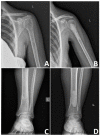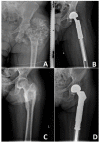Chondrosarcoma-from Molecular Pathology to Novel Therapies
- PMID: 34069269
- PMCID: PMC8155983
- DOI: 10.3390/cancers13102390
Chondrosarcoma-from Molecular Pathology to Novel Therapies
Abstract
Chondrosarcoma (CHS) is the second most common primary malignant bone sarcoma. Overall survival and prognosis of this tumor are various and often extreme, depending on histological grade and tumor subtype. CHS treatment is difficult, and surgery remains still the gold standard due to the resistance of this tumor to other therapeutic options. Considering the role of differentiation of CHS subtypes and the need to develop new treatment strategies, in this review, we introduced a multidisciplinary characterization of CHS from its pathology to therapies. We described the morphology of each subtype with the role of immunohistochemical markers in diagnostics of CHS. We also summarized the most frequently mutated genes and genome regions with altered pathways involved in the pathology of this tumor. Subsequently, we discussed imaging methods and the role of currently used therapies, including surgery and the limitations of chemo and radiotherapy. Finally, in this review, we presented novel targeted therapies, including those at ongoing clinical trials, which can be a potential future target in designing new therapeutics for patients with CHS.
Keywords: chondrosarcoma; diagnostic markers; pathology; therapies.
Conflict of interest statement
The authors declare no conflict of interest.
Figures









Similar articles
-
Molecular In-Depth Characterization of Chondrosarcoma for Current and Future Targeted Therapies.Cancers (Basel). 2023 Apr 29;15(9):2556. doi: 10.3390/cancers15092556. Cancers (Basel). 2023. PMID: 37174021 Free PMC article. Review.
-
Emerging Treatments Targeting the Tumor Microenvironment for Advanced Chondrosarcoma.Cells. 2024 Jun 4;13(11):977. doi: 10.3390/cells13110977. Cells. 2024. PMID: 38891109 Free PMC article. Review.
-
Biological Heterogeneity of Chondrosarcoma: From (Epi) Genetics through Stemness and Deregulated Signaling to Immunophenotype.Cancers (Basel). 2021 Mar 15;13(6):1317. doi: 10.3390/cancers13061317. Cancers (Basel). 2021. PMID: 33804155 Free PMC article. Review.
-
Chondrosarcoma: An overview of clinical behavior, molecular mechanisms mediated drug resistance and potential therapeutic targets.Crit Rev Oncol Hematol. 2018 Nov;131:102-109. doi: 10.1016/j.critrevonc.2018.09.001. Epub 2018 Sep 12. Crit Rev Oncol Hematol. 2018. PMID: 30293700 Review.
-
FBXO22 is a potential therapeutic target for recurrent chondrosarcoma.J Bone Oncol. 2024 May 1;46:100605. doi: 10.1016/j.jbo.2024.100605. eCollection 2024 Jun. J Bone Oncol. 2024. PMID: 38742151 Free PMC article.
Cited by
-
Non-coding RNAs in drug and radiation resistance of bone and soft-tissue sarcoma: a systematic review.Elife. 2022 Nov 3;11:e79655. doi: 10.7554/eLife.79655. Elife. 2022. PMID: 36326232 Free PMC article.
-
Secondary peripheral chondrosarcoma in multiple osteochondromas: a retrospective single-institution case series.Orphanet J Rare Dis. 2024 Feb 13;19(1):63. doi: 10.1186/s13023-023-03006-8. Orphanet J Rare Dis. 2024. PMID: 38351015 Free PMC article.
-
Global research development of chondrosarcoma from 2003 to 2022: a bibliometric analysis.Front Pharmacol. 2024 Aug 2;15:1431958. doi: 10.3389/fphar.2024.1431958. eCollection 2024. Front Pharmacol. 2024. PMID: 39156101 Free PMC article. Review.
-
High-Resolution Secretome Analysis of Chemical Hypoxia Treated Cells Identifies Putative Biomarkers of Chondrosarcoma.Proteomes. 2022 Jul 20;10(3):25. doi: 10.3390/proteomes10030025. Proteomes. 2022. PMID: 35893766 Free PMC article.
-
Impact of the Pretreatment Neutrophil/Lymphocyte Ratio as a Prognostic Factor in Conventional Chondrosarcoma.Indian J Surg Oncol. 2025 Feb;16(1):356-363. doi: 10.1007/s13193-024-02100-y. Epub 2024 Sep 23. Indian J Surg Oncol. 2025. PMID: 40114908
References
Publication types
Grants and funding
LinkOut - more resources
Full Text Sources

